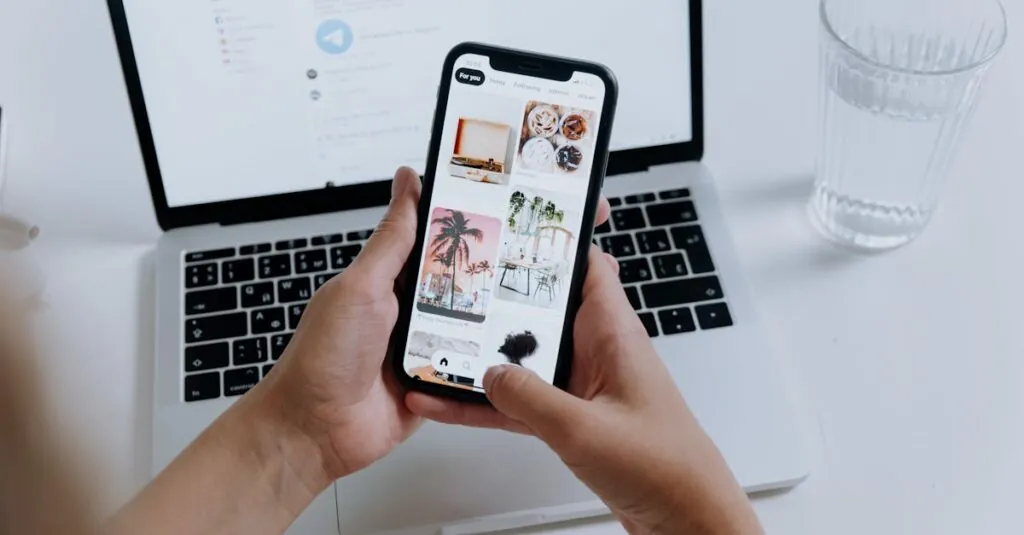Table of Contents
ToggleImagine scrolling through your Google Photos and encountering the same picture of your cat in a dozen different poses. It’s cute, but do you really need that many versions of Whiskers mid-yawn? If your photo library is starting to resemble a game of “Spot the Difference,” it’s time to take action.
Understanding Duplicate Photos
Duplicate photos clutter digital libraries. Identifying their causes helps streamline the photo collection.
Common Causes of Duplicates
Accidental captures lead to duplicates. Taking multiple shots in quick succession often results in similar images. Importing photos from different devices can create copies, especially when using multiple platforms. Also, syncing services may upload the same photo more than once. Editing can sometimes save additional versions of the same photo, causing redundancy. Being unaware of existing images can also contribute to this issue.
Impact on Storage Space
Duplicate photos consume valuable storage space. Each copy takes up memory on devices, making it harder to store new photos and files. For instance, several duplicates can occupy gigabytes of space, leading to potential performance issues. Up to 30 percent of stored images might be duplicates in some collections. Removing these unnecessary files not only frees space but also enhances device efficiency. Managing photo storage effectively ensures a more organized and accessible library.
Using Google Photos App
The Google Photos app provides a straightforward approach to deleting duplicate photos on an iPhone. Users can efficiently manage their photo collections by following specific steps.
Manual Deletion Process
Open the Google Photos app and toggle the “Photos” tab to view the library. Users should scroll through images and identify duplicates manually. Once identified, tap the three-dot menu on the selected photo. Next, select “Delete” to remove the duplicate from the library. Emphasizing thoroughness in the review process ensures that only unnecessary photos are deleted. Each deletion promptly frees up valuable storage space, enhancing device performance.
Identifying Duplicates Easily
Utilize the “For You” tab within Google Photos for suggestions on duplicate images. This feature often highlights similar photos, making the detection process simpler. People can also leverage the search function to spot images with similar timestamps or subjects. By sorting photos by date, users can more easily identify groups of similar images. Additionally, creating albums for organizing photos helps streamline the review process, making it easier to spot duplicates.
Third-Party Apps for Deleting Duplicates
Utilizing third-party apps can significantly simplify the process of removing duplicate photos from Google Photos on an iPhone. These specialized solutions often provide additional features that enhance the user experience, making photo management more efficient.
Benefits of Using Third-Party Solutions
Third-party apps excel in quickly identifying and deleting duplicate images. These applications use advanced algorithms to detect similarities beyond just file names, saving users time. Some apps allow bulk deletion, which permits users to remove multiple duplicates with a single tap. Improved categorization features help maintain a more organized library, enhancing accessibility. Additionally, many of these tools provide a preview option, ensuring that users confirm deletions before permanent removal. This extra layer of security minimizes the risk of losing important photos during the cleanup.
Recommended Apps
Several applications stand out for deleting duplicates effectively. Gemini Photos scans the library and groups similar images for easy comparison. Remo Duplicate Photos Remover focuses on quick identification, allowing users to delete duplicates in bulk. Duplicate Photos Fixer offers customizable scanning options to target specific folders or albums. Cleaner for iPhone provides comprehensive features, including duplicate file identification and management of various media types. Each app has its unique strengths, enabling users to choose the one that best meets their needs for organizing photos.
Best Practices for Preventing Duplicates
Maintaining an organized photo library is essential for preventing duplicates. Implementing a systematic approach can significantly reduce clutter and enhance efficiency.
Organizing Your Photos
Creating folders for specific events or categories aids photo organization. Users can label folders with clear names, making it easier to locate images later. Utilizing tags or keywords assists in identifying similar photos without sifting through galleries. Regularly reviewing and updating folders ensures relevance and helps eliminate unwanted duplicates. Familiarity with Google Photos’ labeling and album features promotes better management of digital archives.
Regular Maintenance Tips
Scheduling routine checks is crucial for preventing duplicates. Users can set reminders to review their photo libraries monthly. Deleting unwanted images promptly helps minimize unnecessary accumulation. Taking advantage of Google Photos’ built-in suggestions for duplicates streamlines the cleanup process. Employing third-party apps periodically strengthens the maintenance routine, providing additional assistance in identifying and removing duplicates quickly.
Deleting duplicate photos in Google Photos on an iPhone can significantly enhance the efficiency of a digital photo library. By following the outlined methods users can effectively streamline their collections and free up valuable storage space. Utilizing both the app’s built-in features and recommended third-party tools simplifies the process, making it easier to manage large volumes of images.
Establishing a routine for reviewing and organizing photos will help prevent future duplicates from accumulating. With these strategies in place, users can enjoy a more organized and accessible photo library that captures their memories without the clutter. Embracing these practices not only improves device performance but also enriches the overall photo management experience.




